Trifolium pratense
Taraxacum officinale
Verbascum thapsus
Potentilla canadensis
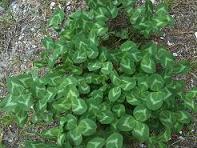
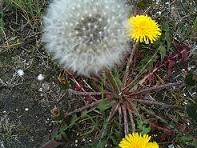
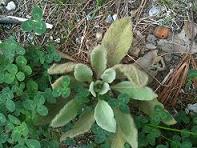
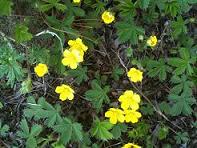
| Red Clover Trifolium pratense |
Common Dandelion Taraxacum officinale |
Common Mullein Verbascum thapsus |
Canadian Dwarf Cinquefoil Potentilla canadensis |
|---|---|---|---|
 |
 |
 |
 |
| Black Mustard (???) Brassica nigra |
Black Mustard Brassica nigra |
Black Mustard Brassica nigra |
Common Plantain Plantago major |
|---|---|---|---|
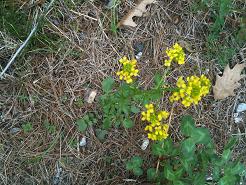 |
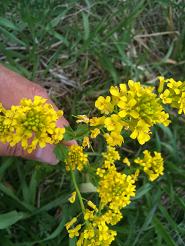 |
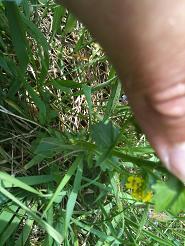 |
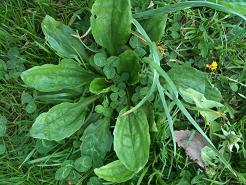 |
| Great Burdock Arctium lappa |
Great Burdock Arctium lappa |
Ground Ivy Glechoma hederacea |
Ground Ivy Glechoma hederacea |
|---|---|---|---|
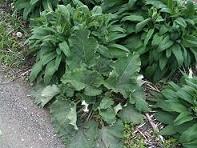 |
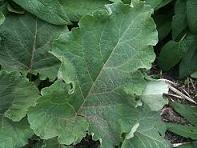 |
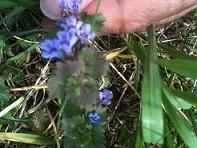 |
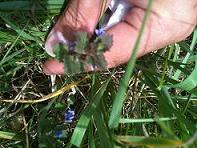 |
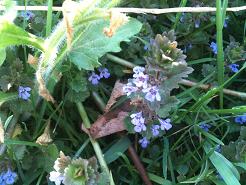
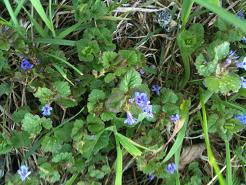 After reading about some of the qualities of Ground Ivy:
(Green Man Ramblings: Ground Ivy;
Ground Ivy: A Weed by Any Other Name)
After reading about some of the qualities of Ground Ivy:
(Green Man Ramblings: Ground Ivy;
Ground Ivy: A Weed by Any Other Name)
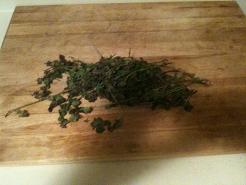
 Ground Ivy is a member of the mint family (Lamiaceae), so the stems are square and it has a slight smell of mint.
It took about 25 minutes to gather the amount shown in the picture. Since the tincture recipe
(Ground Ivy: A Weed by Any Other Name)
called for using just the leaves and flowers, I removed them (time consuming!) and then rinsed
(with spring water) and dried them for a few hours. The rest of the recipe:
Ground Ivy is a member of the mint family (Lamiaceae), so the stems are square and it has a slight smell of mint.
It took about 25 minutes to gather the amount shown in the picture. Since the tincture recipe
(Ground Ivy: A Weed by Any Other Name)
called for using just the leaves and flowers, I removed them (time consuming!) and then rinsed
(with spring water) and dried them for a few hours. The rest of the recipe:
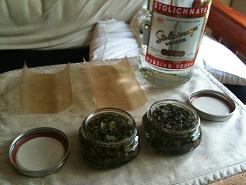
|
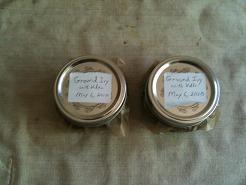
|
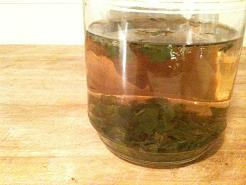
|
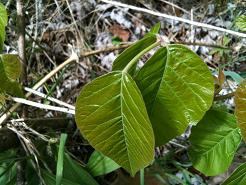
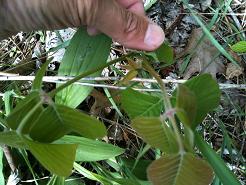 Last year I spent countless hours feeling the leaves of almost every plant trying
to find the stingers of Stinging Nettle (Urtica dioica). I never found Stinging Nettles,
but it wouldn't surprise
me if I had my hands on some Western Poison Ivy. It is extremely common in New England.
Thanks to the Spring
Foraging Class with Arthur Haines, I have at least some ability to identify Western Poison Ivy.
Last year I spent countless hours feeling the leaves of almost every plant trying
to find the stingers of Stinging Nettle (Urtica dioica). I never found Stinging Nettles,
but it wouldn't surprise
me if I had my hands on some Western Poison Ivy. It is extremely common in New England.
Thanks to the Spring
Foraging Class with Arthur Haines, I have at least some ability to identify Western Poison Ivy.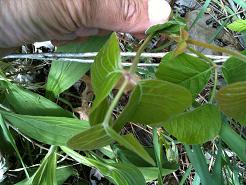
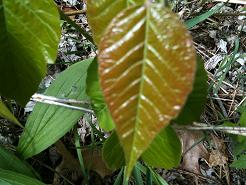 Western Poison Ivy is a deciduous, upright shrub with brown-to-gray woody stems. The leaves alternate up the stem.
Each leaf stalk (petiole) has three leaflets. You can see that the stalk of the central leaflet
is much longer than the stalks of the side leaflets. This is a common feature of poison ivy. The leaf
edges can be slightly lobed or smooth (entire). It seems that there is often (but not always) a slight redish
tinge to some of the leaves. There will be a group of small yellowish flowers and in the Winter, ivory-colored
fruit. A detail description can be found at:
http://www.fs.fed.us/global/iitf/pdf/shrubs/Toxicodendron%20rydbergii.pdf.
Western Poison Ivy is a deciduous, upright shrub with brown-to-gray woody stems. The leaves alternate up the stem.
Each leaf stalk (petiole) has three leaflets. You can see that the stalk of the central leaflet
is much longer than the stalks of the side leaflets. This is a common feature of poison ivy. The leaf
edges can be slightly lobed or smooth (entire). It seems that there is often (but not always) a slight redish
tinge to some of the leaves. There will be a group of small yellowish flowers and in the Winter, ivory-colored
fruit. A detail description can be found at:
http://www.fs.fed.us/global/iitf/pdf/shrubs/Toxicodendron%20rydbergii.pdf.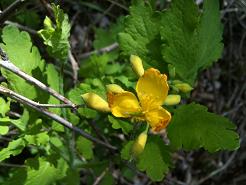
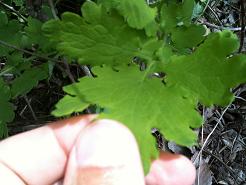 I had no idea what this plant was, but the flower and leaves were very distinctive,
so I took a picture and went to my
Guidebooks
and online resources such as the
New Hampshire Wildflowers web page and their
color thumbnail images. I thought
I'd have no trouble finding a 3-petal yellow flower with heavily lobed leaves. But I was fooled
by this plant. After some detective work, I determined that a flower petal and fallen off and it
was really the 4-petal yellow flower of the herb, celandine. According to
A Modern Herbal by Mrs. M. Grieve,
the dried herb is used to treat liver and gallbladder disorders, eye disorders, cancer and other disorders.
The juice is used externally on warts. However, because of cases of adverse effects from use of commercial
celandine preparations, it has been recommend that consumers only use celandine products when prescribed
by a healthcare professional. See detailed monograph of celandine on page 136 of
Herbal Medicines
(Pharmaceutical Press, 2007). I didn't harvest any celandine because I saw
only one plant and was focused on the snake that slithered by my foot.
I had no idea what this plant was, but the flower and leaves were very distinctive,
so I took a picture and went to my
Guidebooks
and online resources such as the
New Hampshire Wildflowers web page and their
color thumbnail images. I thought
I'd have no trouble finding a 3-petal yellow flower with heavily lobed leaves. But I was fooled
by this plant. After some detective work, I determined that a flower petal and fallen off and it
was really the 4-petal yellow flower of the herb, celandine. According to
A Modern Herbal by Mrs. M. Grieve,
the dried herb is used to treat liver and gallbladder disorders, eye disorders, cancer and other disorders.
The juice is used externally on warts. However, because of cases of adverse effects from use of commercial
celandine preparations, it has been recommend that consumers only use celandine products when prescribed
by a healthcare professional. See detailed monograph of celandine on page 136 of
Herbal Medicines
(Pharmaceutical Press, 2007). I didn't harvest any celandine because I saw
only one plant and was focused on the snake that slithered by my foot.
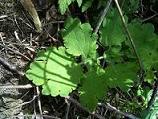
|
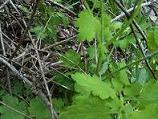
|
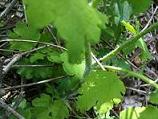
|
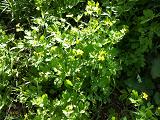
|
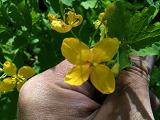
|
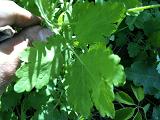
|
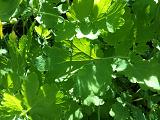
|
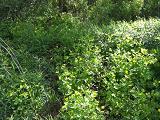
|
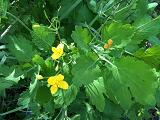
|
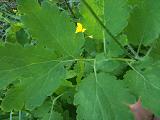
|
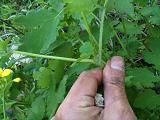
|
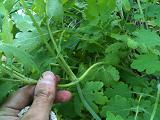
|
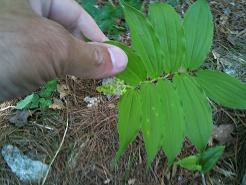
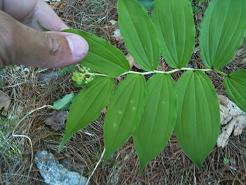 One of the more common plants along the edge of this deciduous tree forest is the Feathery False Solomon's Seal.
This plant is on the side of the trail every couple of feet. The rhizome (underground stem) is edible and can be
collected all year, but it is somewhat fiberous and need to be cooked 30-40 minutes. The dried ground rhizomes
can be made into a tea (decocted) to be used as an expectorant for the lungs. The young shoots are edible
and can be collected in early Spring. I didn't collect any rhizomes because I was on the hunt for the somewhat
tastier (I am told) rhizome of true Solomon's Seal (Polygonatum biflorum).
One of the more common plants along the edge of this deciduous tree forest is the Feathery False Solomon's Seal.
This plant is on the side of the trail every couple of feet. The rhizome (underground stem) is edible and can be
collected all year, but it is somewhat fiberous and need to be cooked 30-40 minutes. The dried ground rhizomes
can be made into a tea (decocted) to be used as an expectorant for the lungs. The young shoots are edible
and can be collected in early Spring. I didn't collect any rhizomes because I was on the hunt for the somewhat
tastier (I am told) rhizome of true Solomon's Seal (Polygonatum biflorum).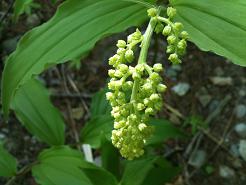 The leaves are similar in shape to the true Solomon's Seal, but the most obvious difference is that the tiny flowers
are all bunched and hanging down from the apex/front of the plant. True Solomon's Seal flowers hang down are various
points below the stem. (See Solomon's Seal pictures below.) The leaves are a pointy oval shaped and alternate
along the stem. Like the Solomon's Seal, the rhizome has swollen nodes, each node indicating one year's worth of growth.
The rhizome of Feathery False Solomon's Seal has an orange tinge, while the rhizome for Solomon's Seal is white.
It can be found in moist woods, clearings and banks. You may notice that Feathery False Solomon's Seal
(Maianthemum racemosum) has the same genus as Canada Mayflower (Maianthemum canadense)
and a similar style of leaf.
The leaves are similar in shape to the true Solomon's Seal, but the most obvious difference is that the tiny flowers
are all bunched and hanging down from the apex/front of the plant. True Solomon's Seal flowers hang down are various
points below the stem. (See Solomon's Seal pictures below.) The leaves are a pointy oval shaped and alternate
along the stem. Like the Solomon's Seal, the rhizome has swollen nodes, each node indicating one year's worth of growth.
The rhizome of Feathery False Solomon's Seal has an orange tinge, while the rhizome for Solomon's Seal is white.
It can be found in moist woods, clearings and banks. You may notice that Feathery False Solomon's Seal
(Maianthemum racemosum) has the same genus as Canada Mayflower (Maianthemum canadense)
and a similar style of leaf.
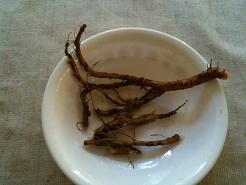
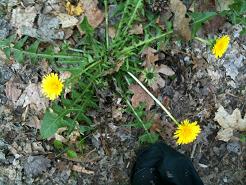 There are quite a bit of dandelion plants in yards and fields, but many of them are
treated with toxic pesticides. On the trail or in abandoned fields may
a good place to collect dandelion roots and leaves. This late in the Spring
the leaves are too tough and bitter to use for food, but the leaves and root
can be dried for a very nutritious tea.
There are quite a bit of dandelion plants in yards and fields, but many of them are
treated with toxic pesticides. On the trail or in abandoned fields may
a good place to collect dandelion roots and leaves. This late in the Spring
the leaves are too tough and bitter to use for food, but the leaves and root
can be dried for a very nutritious tea.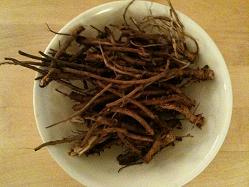
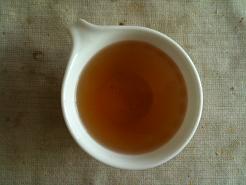 This was my first batch of self-harvested dandelion root tea since the early 1980s!
I cleaned the roots and then dried them in an oven at 175 degrees until the
pieces were brittle (approximately 6 hours). Decided not to roast the roots at
350 degrees for 30-45 minutes. I like the tea better with unroasted roots.
Roasting the root makes the tea taste more like coffee. As you can see from the
picture on the far right, I gathered more dandelion root for drying and brewing.
I'll brew the tea with a touch of dried licorice root or add a bit of honey to
give it a little sweetness.
This was my first batch of self-harvested dandelion root tea since the early 1980s!
I cleaned the roots and then dried them in an oven at 175 degrees until the
pieces were brittle (approximately 6 hours). Decided not to roast the roots at
350 degrees for 30-45 minutes. I like the tea better with unroasted roots.
Roasting the root makes the tea taste more like coffee. As you can see from the
picture on the far right, I gathered more dandelion root for drying and brewing.
I'll brew the tea with a touch of dried licorice root or add a bit of honey to
give it a little sweetness.
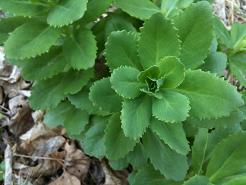
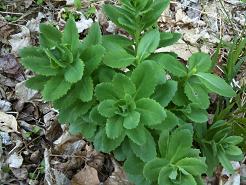 Orpine is one of the most unusual-looking and pleasant-tasting plants I've encountered.
The leaves are very mild-tasting throughout the Spring and Summer and go really
well in salads. You just need to pinch off the upper one or two layers of leaves
and leave the rest of the plant. Orpine does not seem to grow in large swaths,
but instead you will find plants spread out throughout the forest. Therefore,
it's important not to over-harvest so that there is enough for everyone. Just
take the tops of every third or forth plant until you have enough.
Orpine is one of the most unusual-looking and pleasant-tasting plants I've encountered.
The leaves are very mild-tasting throughout the Spring and Summer and go really
well in salads. You just need to pinch off the upper one or two layers of leaves
and leave the rest of the plant. Orpine does not seem to grow in large swaths,
but instead you will find plants spread out throughout the forest. Therefore,
it's important not to over-harvest so that there is enough for everyone. Just
take the tops of every third or forth plant until you have enough.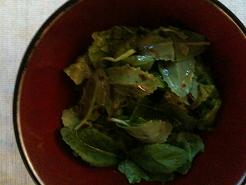 I picked enough for a small salad. Mixed the Orpine with some leaf lettuce.
Added a simple dressing of olive oil and tamari (probably added to much dressing
as you can see). I highly recommend trying Orpine!
I picked enough for a small salad. Mixed the Orpine with some leaf lettuce.
Added a simple dressing of olive oil and tamari (probably added to much dressing
as you can see). I highly recommend trying Orpine!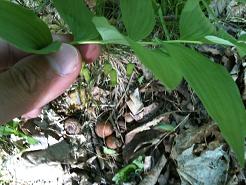
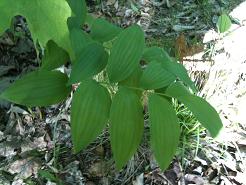 I picked a Solomon's Seal root for soup, but when I got home it was gone!
Thought I put it in my bag, but must have left it by the trailside. I only
picked one root because the true Solomon's Seal was fairly rare along the trail.
There were countless Feathery False Solomon's Seal plants
(Maianthemum racemosum). You can see that one of the main differences
between the plants is that the flowers of the true Solomon's Seal grow all
along the bottom of the stem and hang down. The flowers of the Feathery False
Solomon's Seal grow at the apex/end of the stem. Also the root of the Solomon's
Seal has more pronounced nodes -- each node signifying one year of plant growth.
I picked a Solomon's Seal root for soup, but when I got home it was gone!
Thought I put it in my bag, but must have left it by the trailside. I only
picked one root because the true Solomon's Seal was fairly rare along the trail.
There were countless Feathery False Solomon's Seal plants
(Maianthemum racemosum). You can see that one of the main differences
between the plants is that the flowers of the true Solomon's Seal grow all
along the bottom of the stem and hang down. The flowers of the Feathery False
Solomon's Seal grow at the apex/end of the stem. Also the root of the Solomon's
Seal has more pronounced nodes -- each node signifying one year of plant growth.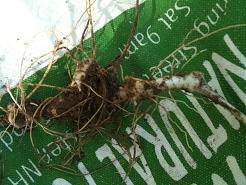 The root of the true Solomon's Seal is reported to be very tasty. Since it contains
calcium oxalate, it should be cooked for 15 minutes or more. The best time to
harvest the root is when the berries are formed, so that the berries can be
replanted to keep the crop coming up in the future. The young shoots can be
eaten raw or cooked. Harvest when the shoots are still curled up and before the
leaves expand. Solomon's Seal looks similar to Feathery False Solomon's Seal and
Bellwort when young.
The root of the true Solomon's Seal is reported to be very tasty. Since it contains
calcium oxalate, it should be cooked for 15 minutes or more. The best time to
harvest the root is when the berries are formed, so that the berries can be
replanted to keep the crop coming up in the future. The young shoots can be
eaten raw or cooked. Harvest when the shoots are still curled up and before the
leaves expand. Solomon's Seal looks similar to Feathery False Solomon's Seal and
Bellwort when young.

|

|

|
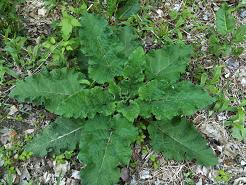
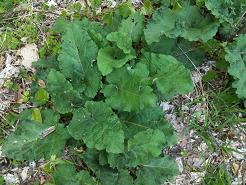 Burdock is a common and unmistakable plant in New England. It is a biennal plant.
Burdock grows as low to the ground rosette of large, wavy, lobed leaves in its first year.
In the second year, a large stalk bolts out of the center of the rosette.
The burdock in the pictures to the right are from a first year plant.
Burdock is a common and unmistakable plant in New England. It is a biennal plant.
Burdock grows as low to the ground rosette of large, wavy, lobed leaves in its first year.
In the second year, a large stalk bolts out of the center of the rosette.
The burdock in the pictures to the right are from a first year plant.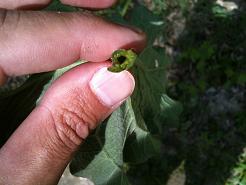 One way to tell the difference between Common Burdock (Arctium minus) and
Greater Burdock (Arctium lappa) is that the stalk of the lower leaves of
the Common Burdock are hollow. Apparently, Greater Burdock is more commonly
cultivated in gardens and sometimes escapes into the wild. I'm sure there are
other ways to tell them apart without having to tear off a leaf.
One way to tell the difference between Common Burdock (Arctium minus) and
Greater Burdock (Arctium lappa) is that the stalk of the lower leaves of
the Common Burdock are hollow. Apparently, Greater Burdock is more commonly
cultivated in gardens and sometimes escapes into the wild. I'm sure there are
other ways to tell them apart without having to tear off a leaf.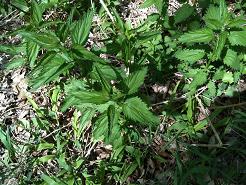
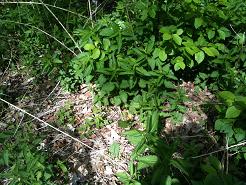 Finally! I found Stinging Nettle after a year of searching! It is fairly common; I just didn't know
what the plant looked like. I picked a small bunch of Stinging Nettle and added it to a onion, burdock, tempeh
and vegetable broth soup I made tonight. I also went back and took a large number of pictures so that I wouldn't
forget what it looks like. See below for the images.
Finally! I found Stinging Nettle after a year of searching! It is fairly common; I just didn't know
what the plant looked like. I picked a small bunch of Stinging Nettle and added it to a onion, burdock, tempeh
and vegetable broth soup I made tonight. I also went back and took a large number of pictures so that I wouldn't
forget what it looks like. See below for the images.| Stinging Nettle Urtica dioica |
Wood Nettle Laportea canadensis |
|---|---|
| Leaves opposite of each other on the stem. | Leaves alternating up the stem. |
| Moderately thin, coursely-toothed leaves. | Slightly ovate (oval), coursely-toothed leaves. |
| Leaves smaller towards the top of the plant. | Leaves larger towards the top of the plant. |
| A couple of dozen or more leaves on the plant. | A dozen or so leaves of the plant. |
| Likes sunnier locations. | Likes shadier locations. |
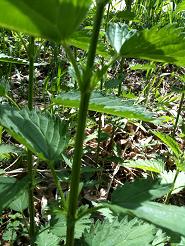
|
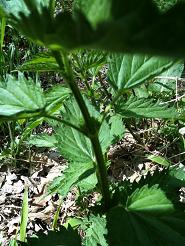
|
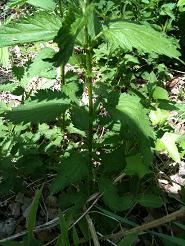
|
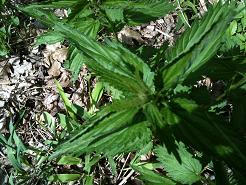
|
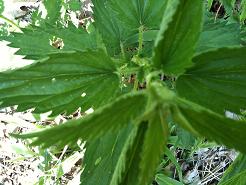
|
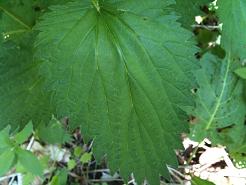
|
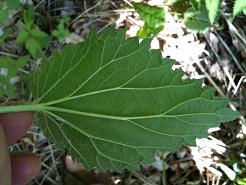
|
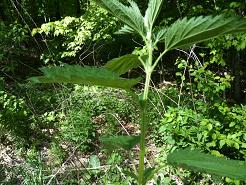
|
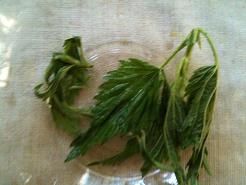
|
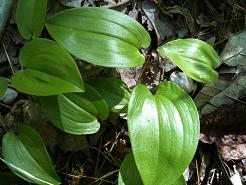
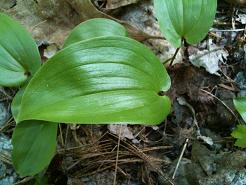 As far as I know, the Canada Mayflower plant is not edible. I took pictures of this plant
and wanted to learn it because it seems to be all over the trails. Often times, I see it
without the umbrel of white flowers -- just countless singles leaves along the trail.
As far as I know, the Canada Mayflower plant is not edible. I took pictures of this plant
and wanted to learn it because it seems to be all over the trails. Often times, I see it
without the umbrel of white flowers -- just countless singles leaves along the trail.
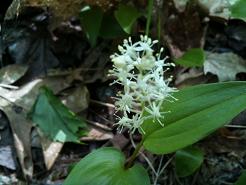
|
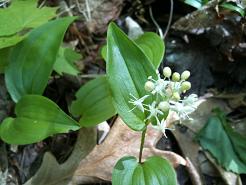
|
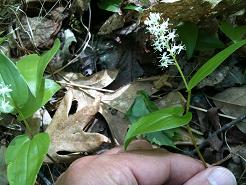
|
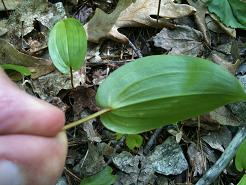
|
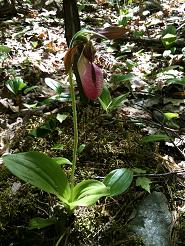
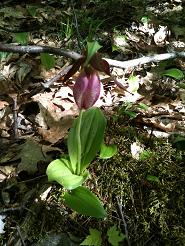 Lady's Slipper is one of the most unusual-looking flowers in the forest.
The flower head looks like a set of lips on its side. It is not used as
an edible food. But it has been used medicinally to treat insomnia, anxiety,
nervous tension and painful menstruation. The roots were gathered in the
Fall or early Spring and dried, ground into a powder and given a teaspoon
at a time in water.
Lady's Slipper is one of the most unusual-looking flowers in the forest.
The flower head looks like a set of lips on its side. It is not used as
an edible food. But it has been used medicinally to treat insomnia, anxiety,
nervous tension and painful menstruation. The roots were gathered in the
Fall or early Spring and dried, ground into a powder and given a teaspoon
at a time in water.
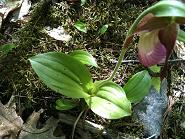
|
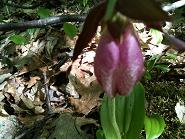
|
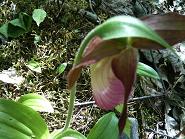
|

|

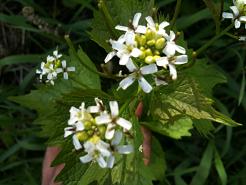 Like the Canada Mayflower (maianthemum canadense), the garlic mustard is
very common on the trail. But I had no idea what it was until ....
Like the Canada Mayflower (maianthemum canadense), the garlic mustard is
very common on the trail. But I had no idea what it was until ....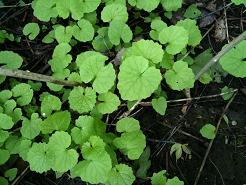
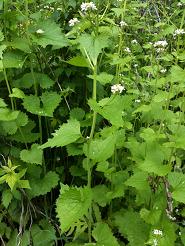 It wasn't until I saw the flowering of a second year of the biennial garlic mustard
that I was able to look it up in the
professional guidebooks. Even with the flower and leaf, it was difficult to find in
these guidebooks. It can be frustrating for beginners like myself!
It wasn't until I saw the flowering of a second year of the biennial garlic mustard
that I was able to look it up in the
professional guidebooks. Even with the flower and leaf, it was difficult to find in
these guidebooks. It can be frustrating for beginners like myself!
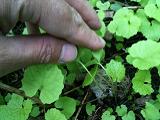
|
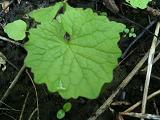
|

|
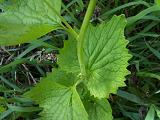
|
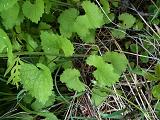
|
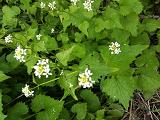
|
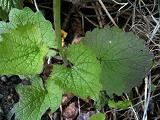
|
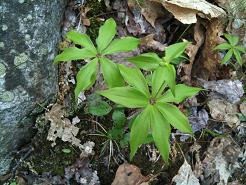
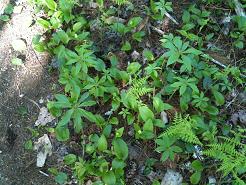 Indian Cucumber is a mild, pleasant-tasting root that can be used in salads or
as a trailside nibble. It has the consistency (not taste) of a soft radish. It does
not taste like cucumber. It has a very mild taste that I can't describe, but
one author has said it was slightly nutty-tasting (although I didn't notice that).
Indian Cucumber is a mild, pleasant-tasting root that can be used in salads or
as a trailside nibble. It has the consistency (not taste) of a soft radish. It does
not taste like cucumber. It has a very mild taste that I can't describe, but
one author has said it was slightly nutty-tasting (although I didn't notice that).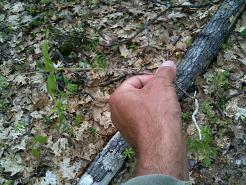
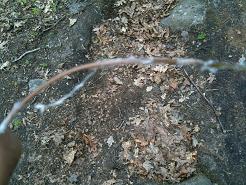 Indian Cucumber is an interesting-looking two-tier plant. About 2/3rds
of the way up the thin stalk is a whorl of 6-10 thin, pointy leaves.
The stalk continues up an inch or two more where there can be found
3 shorter, but proportionally wider leaves at the top of the stalk.
Ocassionally, the top tier of the stalk is nonexistent and therefore
the stalk ends in the whorl of 6-10 leaves.
Indian Cucumber is an interesting-looking two-tier plant. About 2/3rds
of the way up the thin stalk is a whorl of 6-10 thin, pointy leaves.
The stalk continues up an inch or two more where there can be found
3 shorter, but proportionally wider leaves at the top of the stalk.
Ocassionally, the top tier of the stalk is nonexistent and therefore
the stalk ends in the whorl of 6-10 leaves.
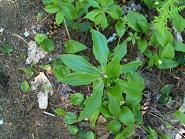
|
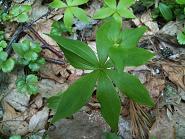
|
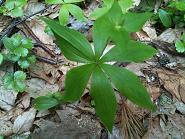
|
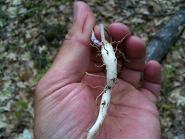
|
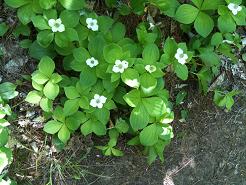
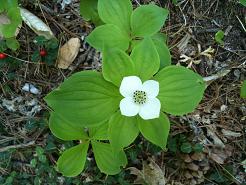 I had heard that Bunchberry could be found along mountain paths, so I was pleasantly
surprised when I saw large swath of Bunchberry in a forest path (not near the
mountains) growing next to large swaths of Wild Strawberries.
I had heard that Bunchberry could be found along mountain paths, so I was pleasantly
surprised when I saw large swath of Bunchberry in a forest path (not near the
mountains) growing next to large swaths of Wild Strawberries.
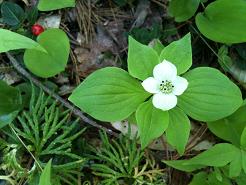
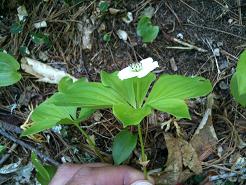
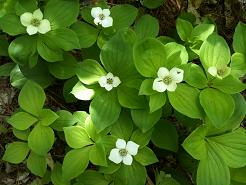
|
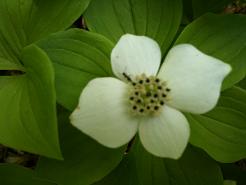
|
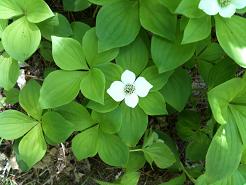
|
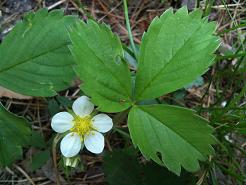
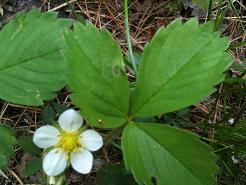 Wild Strawberry is a low-to-the-ground plant with three leaflets on a leaf stalk (petiole).
Each leaflet is sharply-toothed on the upper 50% of the leftlet and without teeth on
the lower portion of the leaflet. One of the distinguishing features of Wild Strawberry
is that the center tooth on each leaflet is noticably smaller than the other teeth.
Wild Strawberry has a 5-petal white flower with a yellow center consisting of approximately
25 stamen. The plant produces long runners (up to 2 feet long) which can re-root and
create new strawberry plants. Wild Strawberry blooms in the late Spring and early
Summer. The is one of the two original strawberry plants that were hybridized to
make the typical garden strawberry. (The other strawberry plant was from Chile.)
Wild Strawberry is a low-to-the-ground plant with three leaflets on a leaf stalk (petiole).
Each leaflet is sharply-toothed on the upper 50% of the leftlet and without teeth on
the lower portion of the leaflet. One of the distinguishing features of Wild Strawberry
is that the center tooth on each leaflet is noticably smaller than the other teeth.
Wild Strawberry has a 5-petal white flower with a yellow center consisting of approximately
25 stamen. The plant produces long runners (up to 2 feet long) which can re-root and
create new strawberry plants. Wild Strawberry blooms in the late Spring and early
Summer. The is one of the two original strawberry plants that were hybridized to
make the typical garden strawberry. (The other strawberry plant was from Chile.)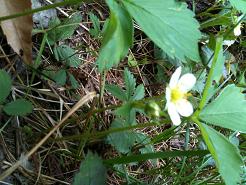
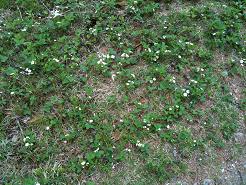 I've seen bunches of Wild Strawberry plants growing almost everywhere.
Along the side of roads, in the forest, near streams. I've never noticed
any strawberries growing, but perhaps I missed them. By early Summer,
we'll see if there's a big strawberry crop to be harvested.
I've seen bunches of Wild Strawberry plants growing almost everywhere.
Along the side of roads, in the forest, near streams. I've never noticed
any strawberries growing, but perhaps I missed them. By early Summer,
we'll see if there's a big strawberry crop to be harvested.
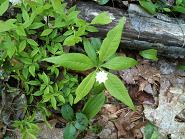
|
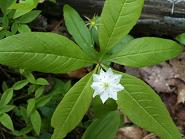
|
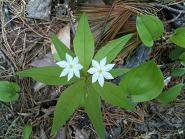
|
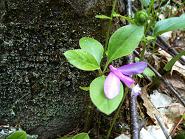
|
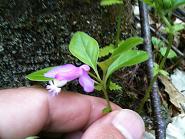
|
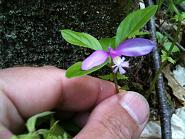
|
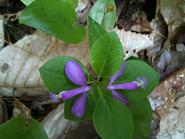
|
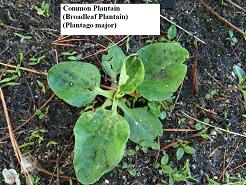
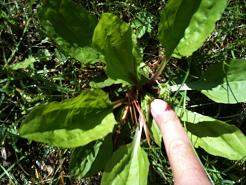 Common or Broadleaf Plantain and Blackseed Plantain are, by far, the two most common
types of plantain in Southeastern, New Hampshire. The rosette of somewhat glossy
leaves and parallel veins on the leaves make it easy to identify. There are a number
of differences between Common or Broadleaf Plantain and Blackseed Plantain. The most
obvious difference as you can see in the images is that the Blackseed
Plantain (left) has a strong redish-purple tinge to the leaf stalks near the base of
the rosette. Common or Broadleaf Plantain (right) almost always has little or no
redish-purple tinge at the base of the rosette.
Common or Broadleaf Plantain and Blackseed Plantain are, by far, the two most common
types of plantain in Southeastern, New Hampshire. The rosette of somewhat glossy
leaves and parallel veins on the leaves make it easy to identify. There are a number
of differences between Common or Broadleaf Plantain and Blackseed Plantain. The most
obvious difference as you can see in the images is that the Blackseed
Plantain (left) has a strong redish-purple tinge to the leaf stalks near the base of
the rosette. Common or Broadleaf Plantain (right) almost always has little or no
redish-purple tinge at the base of the rosette.
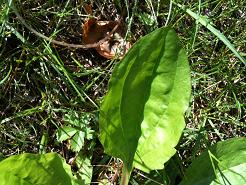 Other differences according to
Weeds of the Northeast include:
Other differences according to
Weeds of the Northeast include: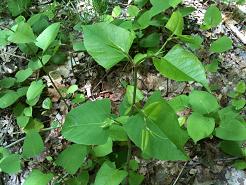
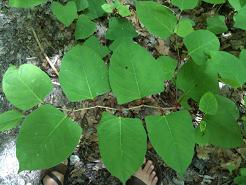 I had been looking for Japanese Knotweed since last year, but I did not really know what
it looked like. But from the pictures, you can see that it is very distinctive and
easy to identify. Notice the large, rounded triangle-shaped leaves that are alternate
on the stem. The bamboo-like stems are thick and hollow (except at the nodes/joints). The
stems have purple blotches. It can grow up to 6 feet tall and it tends to grow in
dense clumbs. It grows along roads, waste areas and untended gardens.
I had been looking for Japanese Knotweed since last year, but I did not really know what
it looked like. But from the pictures, you can see that it is very distinctive and
easy to identify. Notice the large, rounded triangle-shaped leaves that are alternate
on the stem. The bamboo-like stems are thick and hollow (except at the nodes/joints). The
stems have purple blotches. It can grow up to 6 feet tall and it tends to grow in
dense clumbs. It grows along roads, waste areas and untended gardens.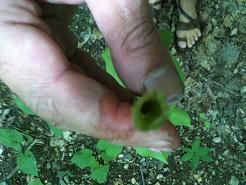
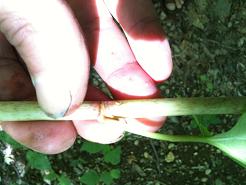 Japanese Knotweed is considered a hard-to-eradicate, invasive weed. But one
way to get rid of Japanese Knotweed is to harvest and eat it! The best time to harvest
Japanese Knotweed is in the early to mid Spring before the plants grow taller than
a few feet. Bend and snap off the upper 6 to 8 inches. Remove the any large leaves.
Rinse and simmer until they turn light green and droopy. Traditional Japanese Itadori
tea can be made by putting young Japanese Knotwood shoots (or coarsely-chopped
tougher stems) in cold water, bring to a boil and then simmer under lower heat
for 20 minutes. Add natural sweetener to taste. There are a huge variety
of ways knotweed can be used in recipies as can be seen in the Japanese Knotweed
Cookoff video below.
Japanese Knotweed is considered a hard-to-eradicate, invasive weed. But one
way to get rid of Japanese Knotweed is to harvest and eat it! The best time to harvest
Japanese Knotweed is in the early to mid Spring before the plants grow taller than
a few feet. Bend and snap off the upper 6 to 8 inches. Remove the any large leaves.
Rinse and simmer until they turn light green and droopy. Traditional Japanese Itadori
tea can be made by putting young Japanese Knotwood shoots (or coarsely-chopped
tougher stems) in cold water, bring to a boil and then simmer under lower heat
for 20 minutes. Add natural sweetener to taste. There are a huge variety
of ways knotweed can be used in recipies as can be seen in the Japanese Knotweed
Cookoff video below.
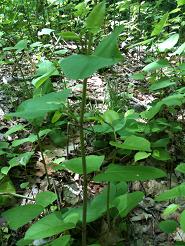
|
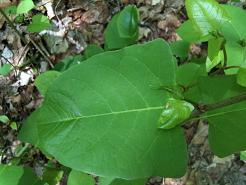
|
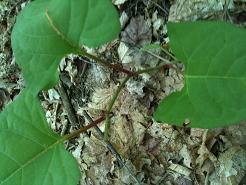
|
Japanese Knotweed Identification / Invasiveness |
Japanese Knotweed Cookoff |
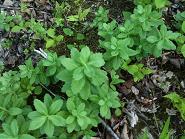
|
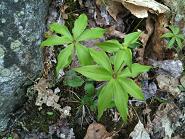
|
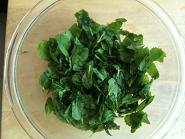
|
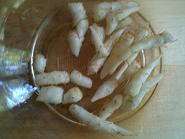
|
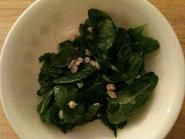
|
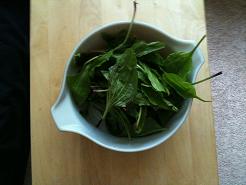
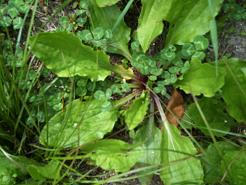 I was hoping to find large patches of Common or Broadleaf Plantain (Plantago major),
but it seems that Blackseed Plantain is more common. Notice the redish-purple tinge
at the base of the leaf stalks of Blackseed Plantain.
I was hoping to find large patches of Common or Broadleaf Plantain (Plantago major),
but it seems that Blackseed Plantain is more common. Notice the redish-purple tinge
at the base of the leaf stalks of Blackseed Plantain.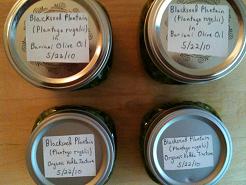
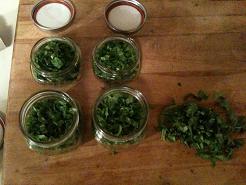 I picked enough plantain leaves to be able to make tinctures, healing oil, and medicinal
tea. For the tincture, I filled (2/3rds full) two half-pint jars with finely chopped
plantain leaves and then filled (to within 1/2 inch of the top) with Rain (brand)
organic 80 proof vodka. The vodka was on sale for only $13.95 per bottle! For the oil,
I filled (2/3rds full) two pint jars with finely chopped plantain leaves and then filled
(to within 1/2 inch of the top) with Bariani (brand) olive oil. Bariani olive oil is
very high quality, unfiltered olive oil. I will turn the tincture and oil bottles
over every day and they should be ready in 6-8 weeks.
I picked enough plantain leaves to be able to make tinctures, healing oil, and medicinal
tea. For the tincture, I filled (2/3rds full) two half-pint jars with finely chopped
plantain leaves and then filled (to within 1/2 inch of the top) with Rain (brand)
organic 80 proof vodka. The vodka was on sale for only $13.95 per bottle! For the oil,
I filled (2/3rds full) two pint jars with finely chopped plantain leaves and then filled
(to within 1/2 inch of the top) with Bariani (brand) olive oil. Bariani olive oil is
very high quality, unfiltered olive oil. I will turn the tincture and oil bottles
over every day and they should be ready in 6-8 weeks.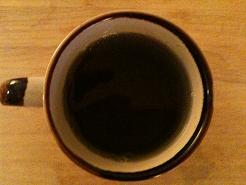 The tea was made by briefly simmering chopped plantain leaves in water for a few minutes
and then letting the leaves steep in the water for a couple of hours. I expected a
bitter taste, but it's surprisingly mild and pleasant.
The tea was made by briefly simmering chopped plantain leaves in water for a few minutes
and then letting the leaves steep in the water for a couple of hours. I expected a
bitter taste, but it's surprisingly mild and pleasant.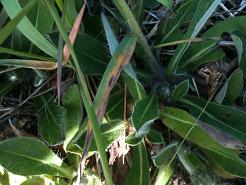
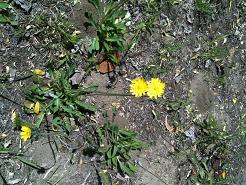 On my walk today, I came across a field of this dandelion-like flower, but it
obviously wasn't dandelion, because the leaves were not toothed. Also, the
flower was not quite the same as dandelion and there was more than one flower per
plant. This one is known in most books as either Yellow Hawkweed or Meadow Hawkweed
and occasionally known as King Devil. Notice in the picture at the far right how the stems
and leaves (both front and back) are extremely hairy. This is differentiated from
Pale Hawkweed (Hieracium floribundum) which looks similar, but only has hairs
on the underside of the leaf. Pale Hawkweed is a hybrid of Meadow Hawkweed
(Hieracium caespitosum) and European Hawkweed (Hieracium lactucella).
On my walk today, I came across a field of this dandelion-like flower, but it
obviously wasn't dandelion, because the leaves were not toothed. Also, the
flower was not quite the same as dandelion and there was more than one flower per
plant. This one is known in most books as either Yellow Hawkweed or Meadow Hawkweed
and occasionally known as King Devil. Notice in the picture at the far right how the stems
and leaves (both front and back) are extremely hairy. This is differentiated from
Pale Hawkweed (Hieracium floribundum) which looks similar, but only has hairs
on the underside of the leaf. Pale Hawkweed is a hybrid of Meadow Hawkweed
(Hieracium caespitosum) and European Hawkweed (Hieracium lactucella).
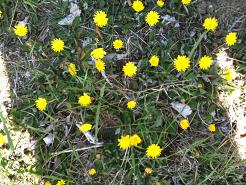
|
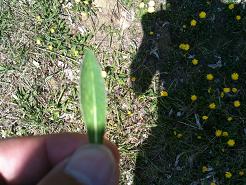
|
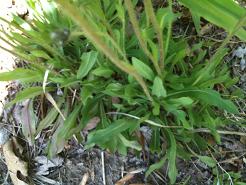
|
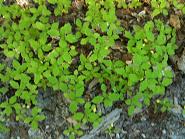
|
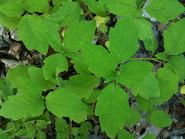
|
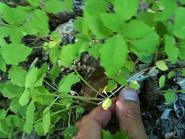
|
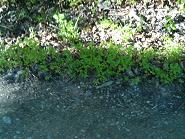
|
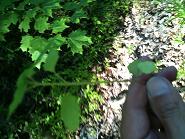
|
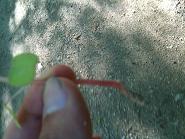
|
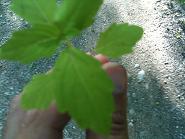
|
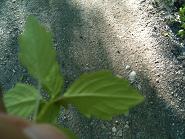
|
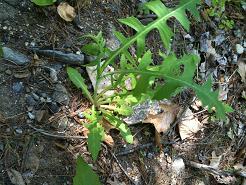
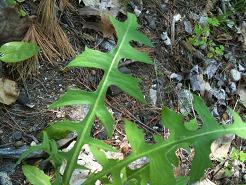 For the first time ever, I found a wild lettuce! During my lunchtime walk, along the
side of a street with a significant amount of plant growth and not much car travel,
there were numerous wild lettuce plants. In this case it was Canada Lettuce
(Lactuca canadensis). There are a few of other Lactuca species in
New Hampshire that look similar: Tall Blue Lettuce (Lactuca biennis),
Hairy Lettuce (Lactuca hirsuta) and Prickly Lettuce (Lactuca serriola).
Tall Blue Lettuce, like Canada lettuce does not have prickles on the leaf margins.
Tall Blue Lettuce has more triangular lobes, toothed margins. Hairy lettuce has hairs
on the stem and leaves and Prickly Lettuce has prickles on the leaf margin and midrib
of the lower surfaces (the upper surface is smooth). Also, the leaves of Prickly
Lettuce have shorter lobes. (Compare picture of
Tall Blue Lettuce,
Canada Lettuce and
Prickly Lettuce at the UMass Herbarium.) While you can't see it in the pictures,
the broken stem exudes a beige-colored sap (not the same white-colored sap seen for
dandelion).
For the first time ever, I found a wild lettuce! During my lunchtime walk, along the
side of a street with a significant amount of plant growth and not much car travel,
there were numerous wild lettuce plants. In this case it was Canada Lettuce
(Lactuca canadensis). There are a few of other Lactuca species in
New Hampshire that look similar: Tall Blue Lettuce (Lactuca biennis),
Hairy Lettuce (Lactuca hirsuta) and Prickly Lettuce (Lactuca serriola).
Tall Blue Lettuce, like Canada lettuce does not have prickles on the leaf margins.
Tall Blue Lettuce has more triangular lobes, toothed margins. Hairy lettuce has hairs
on the stem and leaves and Prickly Lettuce has prickles on the leaf margin and midrib
of the lower surfaces (the upper surface is smooth). Also, the leaves of Prickly
Lettuce have shorter lobes. (Compare picture of
Tall Blue Lettuce,
Canada Lettuce and
Prickly Lettuce at the UMass Herbarium.) While you can't see it in the pictures,
the broken stem exudes a beige-colored sap (not the same white-colored sap seen for
dandelion).
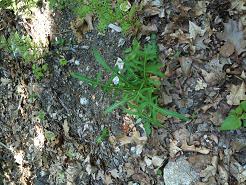 I tasted a couple of leaves and they were pleasant, but there was a very slight
bitterness to them. Not bad, but probably best to use younger leaves and mix
with other greens. I should be able to go back and get a couple of salads from
all of the plants along this sparsley-travelled road.
I tasted a couple of leaves and they were pleasant, but there was a very slight
bitterness to them. Not bad, but probably best to use younger leaves and mix
with other greens. I should be able to go back and get a couple of salads from
all of the plants along this sparsley-travelled road.
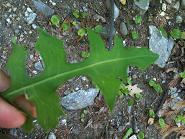
|
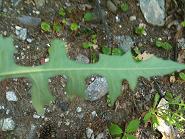
|
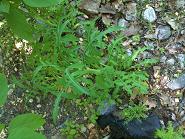
|

|
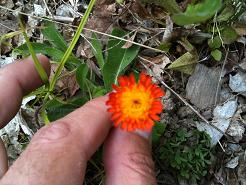
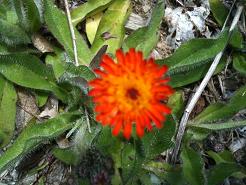 Today was a day less about foraging and more about plant identification.
There's nothing that makes plant identification easier than a plant with a
very distinctive flower in bloom. This plant is very similar to Meadow/Yellow
Hawkweed, but the flower is bright orange with a yellow center. Notice in
the pictures how extremely hairy the stem and the upper and lower surface of
the leaves are. You can see that the leaves are untoothed and unlobed -- not like
dandelion leaves at all (except that they do grow in a rosette).
Today was a day less about foraging and more about plant identification.
There's nothing that makes plant identification easier than a plant with a
very distinctive flower in bloom. This plant is very similar to Meadow/Yellow
Hawkweed, but the flower is bright orange with a yellow center. Notice in
the pictures how extremely hairy the stem and the upper and lower surface of
the leaves are. You can see that the leaves are untoothed and unlobed -- not like
dandelion leaves at all (except that they do grow in a rosette).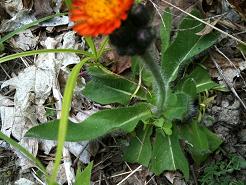
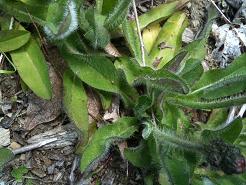 There was bunches of these Orange Hawkweed plants growing near Meadow/Yellow Hawkweed.
I do not think that Orange Hawkweed is used for food or medicine. But it might be
helpful to recognize it and other plants while I learn food and medicine foraging plants.
It does add spectactular color to fields of flowers.
There was bunches of these Orange Hawkweed plants growing near Meadow/Yellow Hawkweed.
I do not think that Orange Hawkweed is used for food or medicine. But it might be
helpful to recognize it and other plants while I learn food and medicine foraging plants.
It does add spectactular color to fields of flowers.
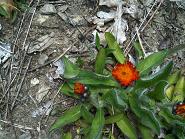
|
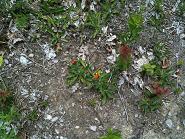
|
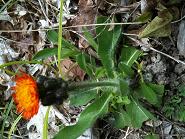
|
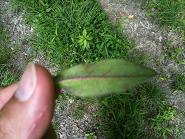
|
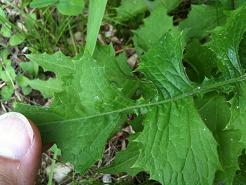
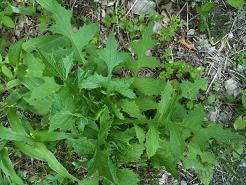 Lettuce identification is such a struggle!!! I am moderately sure that this is Prickly
Lettuce. When looking at Prickly Lettuce pictures online at botany web sites, sometimes
the Prickly Lettuce leaves have significant lobes similar to the pictures to
the right and sometimes there are little or no lobes on the leaves. For example,
the Prickly Lettuce leaves at the
University of Wisconsin Herbarium site have little or no lobes but
the Prickly Lettuce leaves at the
Cal Photos site have significant lobes.
Lettuce identification is such a struggle!!! I am moderately sure that this is Prickly
Lettuce. When looking at Prickly Lettuce pictures online at botany web sites, sometimes
the Prickly Lettuce leaves have significant lobes similar to the pictures to
the right and sometimes there are little or no lobes on the leaves. For example,
the Prickly Lettuce leaves at the
University of Wisconsin Herbarium site have little or no lobes but
the Prickly Lettuce leaves at the
Cal Photos site have significant lobes.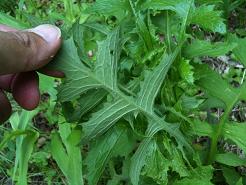
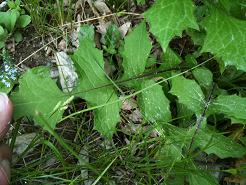 One reason I am confident that this is Prickly Lettuce is that there are obvious
prickles on the edges (margin) of the leaves as well as on the midrib of the lower
leaf surface. Looking at the pictures to the right, you can see the prickles on
the edge of the leaves and can barely make out the prickles on the middle rib
going down the backs of the leaves. Prickly lettuce can look a little bit
like some Sowthistles (Sonchus L.). They both have prickles on the
leaf margin. But one difference is that Sowthistles
are not prickly on the midrib of the underside of the leaf.
One reason I am confident that this is Prickly Lettuce is that there are obvious
prickles on the edges (margin) of the leaves as well as on the midrib of the lower
leaf surface. Looking at the pictures to the right, you can see the prickles on
the edge of the leaves and can barely make out the prickles on the middle rib
going down the backs of the leaves. Prickly lettuce can look a little bit
like some Sowthistles (Sonchus L.). They both have prickles on the
leaf margin. But one difference is that Sowthistles
are not prickly on the midrib of the underside of the leaf.
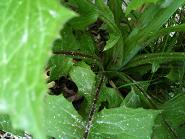
|
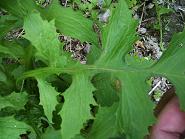
|
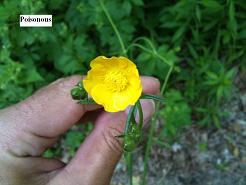
 This is a plant I had not seen since a
Spring 2009 foraging class that I took. The Buttercup from that class was only
a few inches tall. These Buttercup plants are over two feet tall. Notice how the
5-petaled flowers form a yellow cup. The basal leaves are several inches wide and divided
into 3-7 deeped cleft parts. The upper leaves are long, thin and lanceolate.
This is a plant I had not seen since a
Spring 2009 foraging class that I took. The Buttercup from that class was only
a few inches tall. These Buttercup plants are over two feet tall. Notice how the
5-petaled flowers form a yellow cup. The basal leaves are several inches wide and divided
into 3-7 deeped cleft parts. The upper leaves are long, thin and lanceolate.
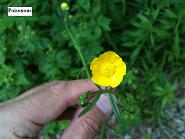
|
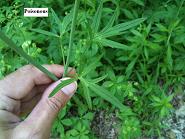
|
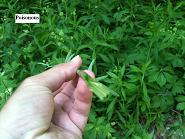
|
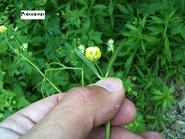
|
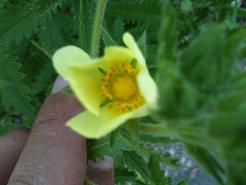
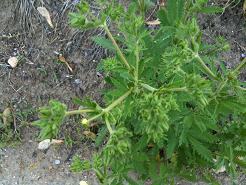 While they still have their yellow flowers, it is time for me to learn the different
Cinquefoils in New Hampshire. I have started a separate
Cinquefoil Identification
web page to help with separating the diferent Cinquefoils. Cinquefoils are a hugely
common plant along the trail. But Sulphur Cinquefoil is much more rare. It is easy
to distinguish from the other Cinquefoils because it is much taller and the flower
lobes are a much lighter yellow or sulphur color. Leaves palmately divided into
5-7 narrowly oval, deeply-toothed leaflets that are 1-3 inches long. The flowers
of other Cinquefoils are darker yellow. It is found in dry fields and weedy places.
While they still have their yellow flowers, it is time for me to learn the different
Cinquefoils in New Hampshire. I have started a separate
Cinquefoil Identification
web page to help with separating the diferent Cinquefoils. Cinquefoils are a hugely
common plant along the trail. But Sulphur Cinquefoil is much more rare. It is easy
to distinguish from the other Cinquefoils because it is much taller and the flower
lobes are a much lighter yellow or sulphur color. Leaves palmately divided into
5-7 narrowly oval, deeply-toothed leaflets that are 1-3 inches long. The flowers
of other Cinquefoils are darker yellow. It is found in dry fields and weedy places.
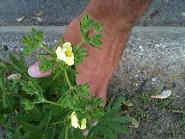
|
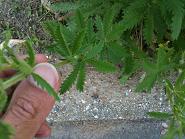
|
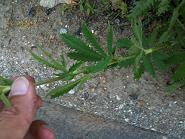
|
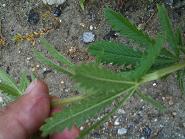
|
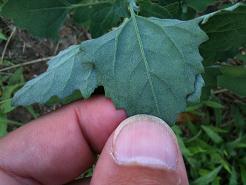
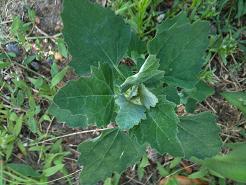 Last year I picked and ate leaves from lambsquarters plants that were growing as a
“weed” in my garden. It was probably the healthiest crop that grew in
my garden. Today I was walking down the street and was surprised to come across this
lambsquarters growing in front of a house.
Last year I picked and ate leaves from lambsquarters plants that were growing as a
“weed” in my garden. It was probably the healthiest crop that grew in
my garden. Today I was walking down the street and was surprised to come across this
lambsquarters growing in front of a house.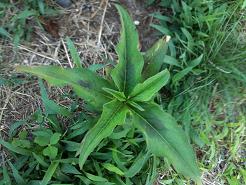
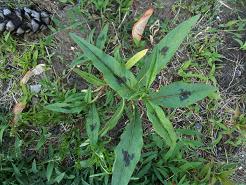 What a surprise to find a bunch of Spotted Ladysthumb plants along the street next to
a Lambsquarters. Spotted Ladysthumb is an edible foraging plant. Pick the leaves.
Wash and cook for less than 10 minutes.
What a surprise to find a bunch of Spotted Ladysthumb plants along the street next to
a Lambsquarters. Spotted Ladysthumb is an edible foraging plant. Pick the leaves.
Wash and cook for less than 10 minutes.
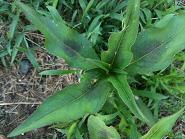
|
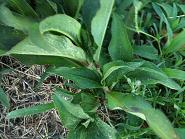
|
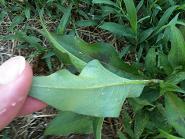
|
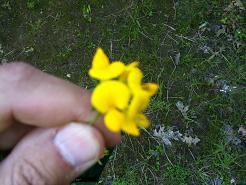
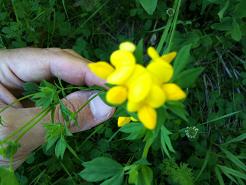 Every time I see a yellow flower I get excited because I think it‘s
St. John‘s Wort. It turns out that it is not St. John‘s Wort, but
it is the very distinctive perennial herb, Bird‘s-Foot Trefoil.
3-6 yellow pea-like flowers form an umbrel at the top of the stem. The flowers
have an appearance of a bird‘s foot. Leaves are compound, made up of
3 cover-like leaflets. At the base of the leaf stalk are two stipules that
also look like clover leaves and sometimes give the appearance that the leaf
has 5 leaflets. See images below and to the right to see the leaflets and
stipules. The plant is many-stemmed and can grow from 6 to 24 inches high.
Every time I see a yellow flower I get excited because I think it‘s
St. John‘s Wort. It turns out that it is not St. John‘s Wort, but
it is the very distinctive perennial herb, Bird‘s-Foot Trefoil.
3-6 yellow pea-like flowers form an umbrel at the top of the stem. The flowers
have an appearance of a bird‘s foot. Leaves are compound, made up of
3 cover-like leaflets. At the base of the leaf stalk are two stipules that
also look like clover leaves and sometimes give the appearance that the leaf
has 5 leaflets. See images below and to the right to see the leaflets and
stipules. The plant is many-stemmed and can grow from 6 to 24 inches high.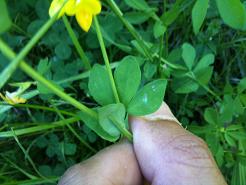
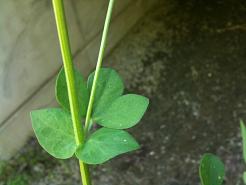 Bird‘s-Foot Trefoil tea is reported to be useful for treating chronic nervousness,
long-term depression, sleep disorders (including insomnia) and heart palpitations.
However, parts of the plants contain small, but varying levels of a toxic cyanogenic
glycoside. To be safe, only use this plant medicinally under the supervision of an
experienced clinical herbalist. In Colonial times, the flowers were used to dye
cotton and woolen products. Honey produced by bees near Bird‘s-Foot Trefoil
is said to have superb taste. Numerous articles have been written in bee and
agriculture scientific journals on the use of Bird‘s-Foot Trefoil by
beekeepers.
Bird‘s-Foot Trefoil tea is reported to be useful for treating chronic nervousness,
long-term depression, sleep disorders (including insomnia) and heart palpitations.
However, parts of the plants contain small, but varying levels of a toxic cyanogenic
glycoside. To be safe, only use this plant medicinally under the supervision of an
experienced clinical herbalist. In Colonial times, the flowers were used to dye
cotton and woolen products. Honey produced by bees near Bird‘s-Foot Trefoil
is said to have superb taste. Numerous articles have been written in bee and
agriculture scientific journals on the use of Bird‘s-Foot Trefoil by
beekeepers.
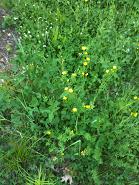
|
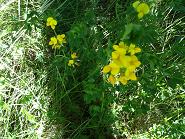
|
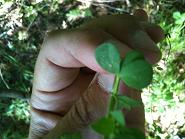
|
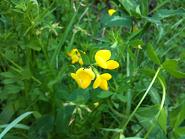
|
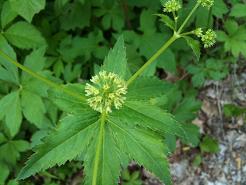
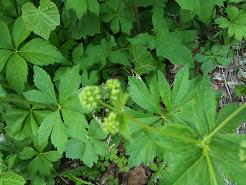 In his classic book,
Back to Eden,
herbalist Jethro Kloss describes Black Snakeroot (Sanicula marilandica) in
this way:
In his classic book,
Back to Eden,
herbalist Jethro Kloss describes Black Snakeroot (Sanicula marilandica) in
this way: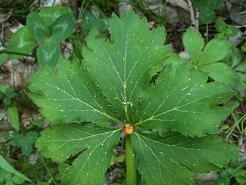
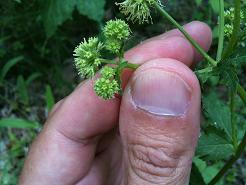 There are four Sanicula species in New Hampshire. I started a
Sanicula Identification web page to help me differentiate between the four species.
Maryland Black Snakeroot grows on a stout, 1-1/2 foot to 4 foot stem with leaves
growing around the stem at intervals. Each leaf consists of 3-7 leaflets in a whorl.
The leaflets have deep teeth and are double-toothed (look closely at the picture
above on the right (near the start of the Maryland Black Snakeroot section), and you
will see sets of “double-teeth” on the edge of the leaflets. The leaflets
of the lower leaves tend to be somewhat lobed and toothed. The leaflets on the
upper leaves are more lanceolate and unlobed.
There are four Sanicula species in New Hampshire. I started a
Sanicula Identification web page to help me differentiate between the four species.
Maryland Black Snakeroot grows on a stout, 1-1/2 foot to 4 foot stem with leaves
growing around the stem at intervals. Each leaf consists of 3-7 leaflets in a whorl.
The leaflets have deep teeth and are double-toothed (look closely at the picture
above on the right (near the start of the Maryland Black Snakeroot section), and you
will see sets of “double-teeth” on the edge of the leaflets. The leaflets
of the lower leaves tend to be somewhat lobed and toothed. The leaflets on the
upper leaves are more lanceolate and unlobed.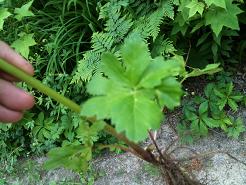
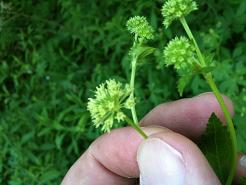 As a member of the carrot family, the flowers grow as umbrel (all of the little flowers
attached to the same spot on the flowering stem and all of the flowers
individually stalked). One of the distinguishing
characteristic of Maryland Black Snakeroot is the the styles (stalk of the pistils) are
slightly curved and longer than the prickles of the ovary. The styles of most other
Sanicula species are the same length or shorter than the prickles of the ovary.
Click on and expand the picture up above on the left. If you look very closely, you
will see numerous prickles with little hooks attached to the ovary. But you can also see
a somewhat faint style stalk sticking out to the left that is longer than
the prickles with hooks. Clustered Black Snakeroot (Sanicula odorata) has long
styles as well, but the ovary has a short stalk and the sepals are shorter (only
0.5-1.0 mm long as opposed to 1-2 mm long).
As a member of the carrot family, the flowers grow as umbrel (all of the little flowers
attached to the same spot on the flowering stem and all of the flowers
individually stalked). One of the distinguishing
characteristic of Maryland Black Snakeroot is the the styles (stalk of the pistils) are
slightly curved and longer than the prickles of the ovary. The styles of most other
Sanicula species are the same length or shorter than the prickles of the ovary.
Click on and expand the picture up above on the left. If you look very closely, you
will see numerous prickles with little hooks attached to the ovary. But you can also see
a somewhat faint style stalk sticking out to the left that is longer than
the prickles with hooks. Clustered Black Snakeroot (Sanicula odorata) has long
styles as well, but the ovary has a short stalk and the sepals are shorter (only
0.5-1.0 mm long as opposed to 1-2 mm long).

|
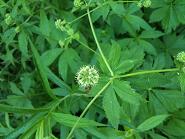
|
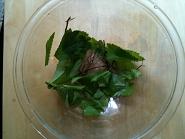
|
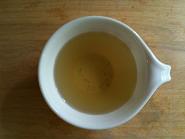
|
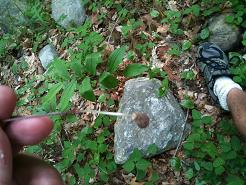
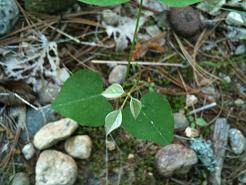 This was an important foraging find! Hog Peanut is a low-growing vine with
delicate leaves that have three leaflets. The leaflets are ovate and somewhat
triangular in shape with an untoothed (entire) margin. The center leaflet has
a longer stalk than the other two leaflets. I have found Hog Peanut in areas
of deciduous trees along the side of trails. The flower (not shown) is a purple
flower that looks a little bit like two jewelweed flowers facing away from each
other.
This was an important foraging find! Hog Peanut is a low-growing vine with
delicate leaves that have three leaflets. The leaflets are ovate and somewhat
triangular in shape with an untoothed (entire) margin. The center leaflet has
a longer stalk than the other two leaflets. I have found Hog Peanut in areas
of deciduous trees along the side of trails. The flower (not shown) is a purple
flower that looks a little bit like two jewelweed flowers facing away from each
other.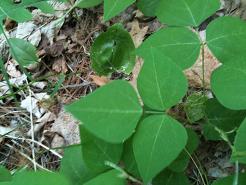
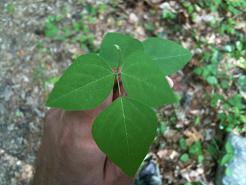
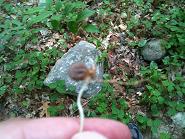
|
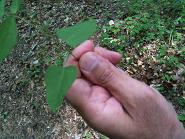
|
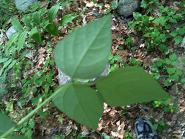
|
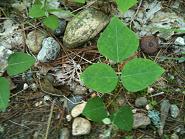
|
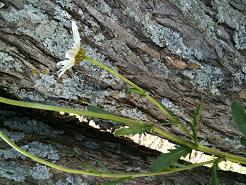
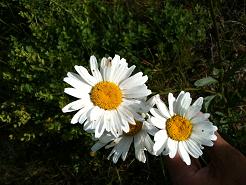 Oxeye Daisy is a one to three foot flowering member of the Aster family. The flower
has 15-30 white rays with a yellow disk in the center. The leaves are coarsely toothed
or pinnately lobed. The leaves alternate up the stem. The leaves tend to
get progressively smaller from the base to the top of the stem. Oxeye Daisy blooms
from late May through August. It can be found in fields and along roadsides.
Oxeye Daisy is a one to three foot flowering member of the Aster family. The flower
has 15-30 white rays with a yellow disk in the center. The leaves are coarsely toothed
or pinnately lobed. The leaves alternate up the stem. The leaves tend to
get progressively smaller from the base to the top of the stem. Oxeye Daisy blooms
from late May through August. It can be found in fields and along roadsides.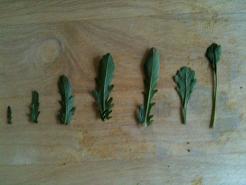
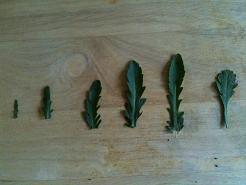 The leaves of the Oxeye Daisy can be harvested from the Spring through the Autumn.
Apparently, the basal leaves tend the be the most succulent. The chopped leaves are use
as flavoring in a salad (not the main part of the salad). The flowers are edible as well
and reportedly have been used to make wine. The young shoots (leaves, stems and flower
buds) can be harvested for food as well. Oxeye Daisy contains more Pro-Vitamin A
(Caretenoids) than Spinach. The flowers are used medicinally in an infusion for fevers,
to reduce spasms or cramps, for anti-inflammatory effects and as a Spring tonic.
The leaves of the Oxeye Daisy can be harvested from the Spring through the Autumn.
Apparently, the basal leaves tend the be the most succulent. The chopped leaves are use
as flavoring in a salad (not the main part of the salad). The flowers are edible as well
and reportedly have been used to make wine. The young shoots (leaves, stems and flower
buds) can be harvested for food as well. Oxeye Daisy contains more Pro-Vitamin A
(Caretenoids) than Spinach. The flowers are used medicinally in an infusion for fevers,
to reduce spasms or cramps, for anti-inflammatory effects and as a Spring tonic.
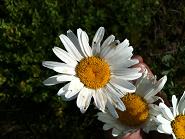
|
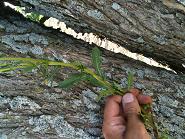
|
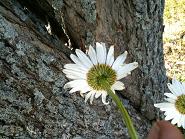
|
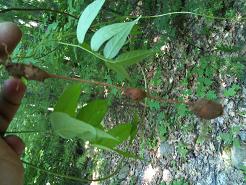
 This is perhaps my biggest foraging find! I had been looking for Groundnut since
last year, but did not realize that it is a vine. Here is what Henry David Thoreau
wrote about Groundnut in
Walden Pond:
This is perhaps my biggest foraging find! I had been looking for Groundnut since
last year, but did not realize that it is a vine. Here is what Henry David Thoreau
wrote about Groundnut in
Walden Pond: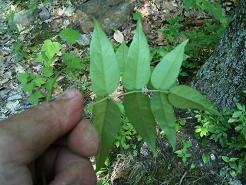
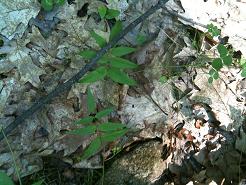 Cultivation has well-nigh exterminated it. It has a
sweetish taste, much like that of a frost-bitten potato, and I found it better boiled
than roasted. This tuber seemed like a faint promise of Nature to rear her own children
and feed them simply here at some future period. In these days of fatted cattle and
waving grain-fields this humble root, which was once the totem of an Indian tribe, is
quite forgotten, or known only by its flowering vine; but let wild Nature reign here once
more, and the tender and luxurious English grains will probably disappear before a
myriad of foes, and without the care of man the crow may carry back even the last seed
of corn to the great cornfield of the Indian's God in the southwest, whence he is said
to have brought it; but the now almost exterminated ground-nut will perhaps revive and
flourish in spite of frosts and wildness, prove itself indigenous, and resume its
ancient importance and dignity as the diet of the hunter tribe. Some Indian Ceres or
Minerva must have been the inventor and bestower of it; and when the reign of
poetry commences here, its leaves and string of nuts may be represented on our works
of art.
Cultivation has well-nigh exterminated it. It has a
sweetish taste, much like that of a frost-bitten potato, and I found it better boiled
than roasted. This tuber seemed like a faint promise of Nature to rear her own children
and feed them simply here at some future period. In these days of fatted cattle and
waving grain-fields this humble root, which was once the totem of an Indian tribe, is
quite forgotten, or known only by its flowering vine; but let wild Nature reign here once
more, and the tender and luxurious English grains will probably disappear before a
myriad of foes, and without the care of man the crow may carry back even the last seed
of corn to the great cornfield of the Indian's God in the southwest, whence he is said
to have brought it; but the now almost exterminated ground-nut will perhaps revive and
flourish in spite of frosts and wildness, prove itself indigenous, and resume its
ancient importance and dignity as the diet of the hunter tribe. Some Indian Ceres or
Minerva must have been the inventor and bestower of it; and when the reign of
poetry commences here, its leaves and string of nuts may be represented on our works
of art.
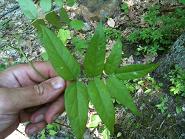
|

|
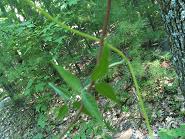
|
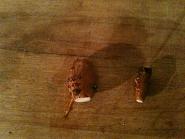
|
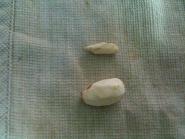
|
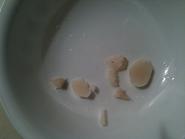
|